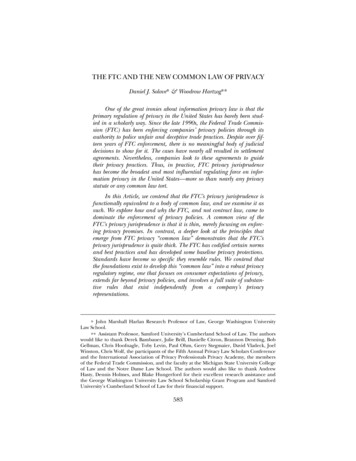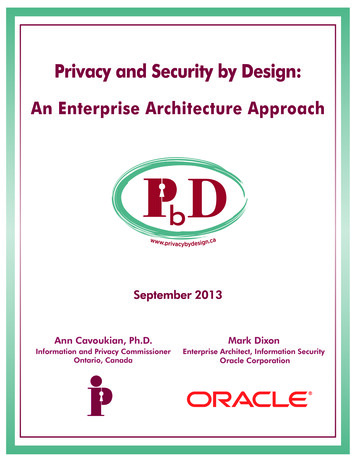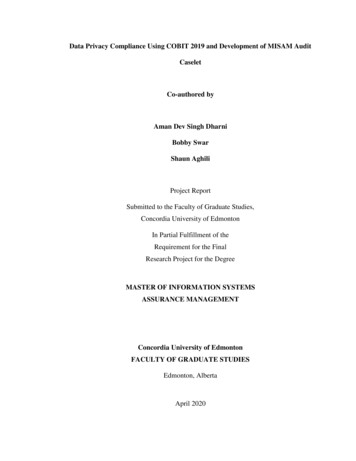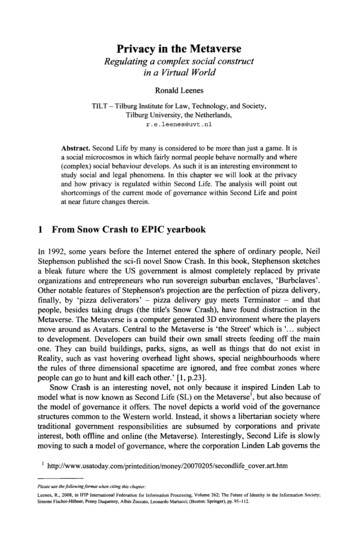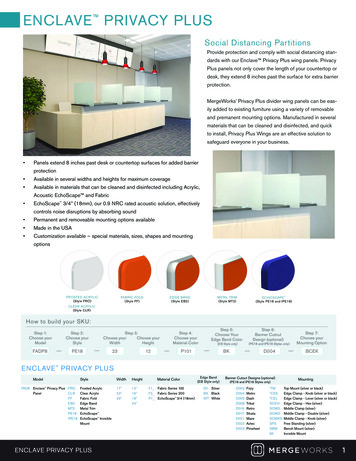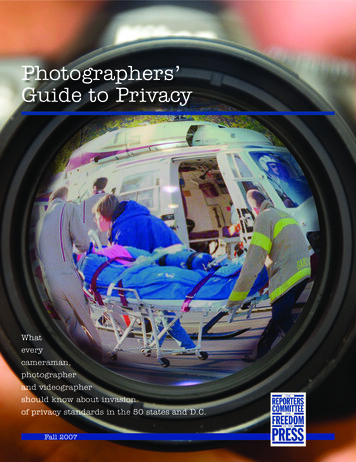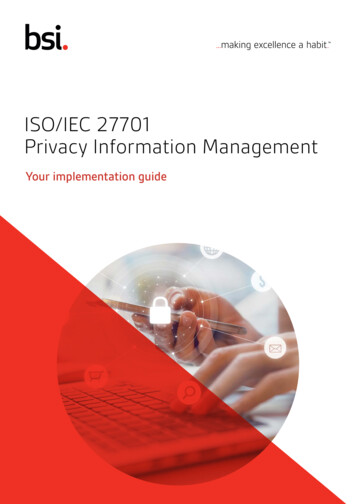
Transcription
THE NO-HASSLE GUIDETO HIPAA POLICIESA Privacy and Security ToolkitKate Borten, CISSP, CISMSecond Edition
The No-Hassle Guide to HIPAA Policies: A Privacy and Security Toolkit, Second Edition, is publishedby HCPro, a division of BLR.Copyright 2014 HCPro, a division of BLR.All rights reserved. Printed in the United States of America.5 4 3 2 1Download the sample policies and forms in this book with the purchase of this product.ISBN: 978-1-61569-335-1No part of this publication may be reproduced, in any form or by any means, without prior writtenconsent of HCPro, a division of BLR, or the Copyright Clearance Center (978-750-8400). Please notifyus immediately if you have received an unauthorized copy.HCPro, a division of BLR, provides information resources for the healthcare industry.HCPro, a division of BLR, is not affiliated in any way with The Joint Commission, which owns theJCAHO and Joint Commission trademarks.Kate Borten, CISSP, CISM, AuthorElizabeth Petersen, Vice PresidentGerianne Spanek, Managing EditorMatt Sharpe, Senior Manager of ProductionErin Callahan, Senior Product DirectorMichael McCalip, Graphic Designer/LayoutMelissa Osborn, Product DirectorKelly Church, Graphic Designer/CoverAdvice given is general. Readers should consult professional counsel for specific legal, ethical, orclinical questions.Arrangements can be made for quantity discounts. For more information, contact:HCPro, a division of BLR75 Sylvan Street, Suite A-101Danvers, MA 01923Telephone: 800-650-6787 or 781-639-1872Fax: 800-639-8511Email: customerservice@hcpro.comVisit HCPro online at www.hcpro.com and www.hcmarketplace.com
ContentAbout the Author . . . . . . . . . . . . . . . . . . . . . . . . . . . . . . . . . . . . . . . . . . . . . . . . . . . . . . . . . . . viAcknowledgments . . . . . . . . . . . . . . . . . . . . . . . . . . . . . . . . . . . . . . . . . . . . . . . . . . . . . . . . . viiPreface . . . . . . . . . . . . . . . . . . . . . . . . . . . . . . . . . . . . . . . . . . . . . . . . . . . . . . . . . . . . . . . . . . viiiIntroduction . . . . . . . . . . . . . . . . . . . . . . . . . . . . . . . . . . . . . . . . . . . . . . . . . . . . . . . . . . . . . . . 1Terms . . . . . . . . . . . . . . . . . . . . . . . . . . . . . . . . . . . . . . . . . . . . . . . . . . . . . . . . . . . . . . . . . . . . . . 1All About Policies . . . . . . . . . . . . . . . . . . . . . . . . . . . . . . . . . . . . . . . . . . . . . . . . . . . . . . . . . . . . . 3What Are HIPAA Policies? . . . . . . . . . . . . . . . . . . . . . . . . . . . . . . . . . . . . . . . . . . . . . . . . . . . . . . . 7How to Use This Book . . . . . . . . . . . . . . . . . . . . . . . . . . . . . . . . . . . . . . . . . . . . . . . . . . . . . . . . . 8Section I: Where Privacy and Security Intersect . . . . . . . . . . . . . . . . . . . . . . . . . . . . . . . . . . . 11A. Roles and Responsibilities . . . . . . . . . . . . . . . . . . . . . . . . . . . . . . . . . . . . . . . . . . . . . . . . . . . . . 13B. Combined Privacy and Security Policies . . . . . . . . . . . . . . . . . . . . . . . . . . . . . . . . . . . . . . . . . . 27Section II: Privacy . . . . . . . . . . . . . . . . . . . . . . . . . . . . . . . . . . . . . . . . . . . . . . . . . . . . . . . . . 47Other Regulations . . . . . . . . . . . . . . . . . . . . . . . . . . . . . . . . . . . . . . . . . . . . . . . . . . . . . . . . . . . . . 47Forms . . . . . . . . . . . . . . . . . . . . . . . . . . . . . . . . . . . . . . . . . . . . . . . . . . . . . . . . . . . . . . . . . . . . . . 48A. Covered Entity Use and Disclosure of PHI . . . . . . . . . . . . . . . . . . . . . . . . . . . . . . . . . . . . . . . . . 48B. Individual Privacy Rights Concerning PHI . . . . . . . . . . . . . . . . . . . . . . . . . . . . . . . . . . . . . . . . . 85Section III: Security . . . . . . . . . . . . . . . . . . . . . . . . . . . . . . . . . . . . . . . . . . . . . . . . . . . . . . . 121A. Administrative Safeguards . . . . . . . . . . . . . . . . . . . . . . . . . . . . . . . . . . . . . . . . . . . . . . . . . . . . 122B. Physical Safeguards . . . . . . . . . . . . . . . . . . . . . . . . . . . . . . . . . . . . . . . . . . . . . . . . . . . . . . . . . 139C. Technical Safeguards . . . . . . . . . . . . . . . . . . . . . . . . . . . . . . . . . . . . . . . . . . . . . . . . . . . . . . . . 154Appendix . . . . . . . . . . . . . . . . . . . . . . . . . . . . . . . . . . . . . . . . . . . . . . . . . . . . . . . . . . . . . . . 171Glossary of HIPAA Terms . . . . . . . . . . . . . . . . . . . . . . . . . . . . . . . . . . . . . . . . . . . . . . . . . . . . . . 171The No-Hassle Guide to HIPAA Policiesiii
Policies and FormsSection IPolicy 1: Designation of Privacy Officer . . . . . . . . . . . . . . . . . . . . . . . . . . . . . . . . . . . . . . . . . . . . . . .Form 1: Chief Privacy Officer Job Description . . . . . . . . . . . . . . . . . . . . . . . . . . . . . . . . . . . . . . . . . . .Form 2: Chief Information Security Officer Job Description . . . . . . . . . . . . . . . . . . . . . . . . . . . . . . . . .Policy 2: Information Security Program Governance . . . . . . . . . . . . . . . . . . . . . . . . . . . . . . . . . . . . . .Policy 3: Information Asset Protection Responsibility . . . . . . . . . . . . . . . . . . . . . . . . . . . . . . . . . . . . . .Policy 4: Sanctions for Privacy and Security Violations . . . . . . . . . . . . . . . . . . . . . . . . . . . . . . . . . . . .Policy 5: Confidential Data Protections . . . . . . . . . . . . . . . . . . . . . . . . . . . . . . . . . . . . . . . . . . . . . . . .Policy 6: Privacy and Security Incident Response and Breach Notification . . . . . . . . . . . . . . . . . . . . .Policy 7: Minimum Necessary Access and Disclosure . . . . . . . . . . . . . . . . . . . . . . . . . . . . . . . . . . . . .Policy 8: Document Retention . . . . . . . . . . . . . . . . . . . . . . . . . . . . . . . . . . . . . . . . . . . . . . . . . . . . . .Form 3: Confidentiality Acknowledgment . . . . . . . . . . . . . . . . . . . . . . . . . . . . . . . . . . . . . . . . . . . . . .Policy 9: Managing Business Associates . . . . . . . . . . . . . . . . . . . . . . . . . . . . . . . . . . . . . . . . . . . . . . .151617192229323437383940Section IIPolicy 10: Uses and Disclosures of PHI for Treatment, Payment, and Healthcare Operations . . . . . . . . 51Policy 11: Uses and Disclosures of PHI Not Requiring Permission or Opportunity to Agree or Object . 53Policy 12: Uses and Disclosures of PHI for Research . . . . . . . . . . . . . . . . . . . . . . . . . . . . . . . . . . . . . 58Form 4: Request for Waiver of Authorization for Research . . . . . . . . . . . . . . . . . . . . . . . . . . . . . . . . . . 65Policy 13: Uses and Disclosures for PHI for Care Involvement and for Notification . . . . . . . . . . . . . . . 67Policy 14: Uses and Disclosures of PHI in Facility Directories . . . . . . . . . . . . . . . . . . . . . . . . . . . . . . . 69Form 5: Directory Preferences . . . . . . . . . . . . . . . . . . . . . . . . . . . . . . . . . . . . . . . . . . . . . . . . . . . . . . 71Policy 15: Uses and Disclosures of PHI for Fundraising . . . . . . . . . . . . . . . . . . . . . . . . . . . . . . . . . . . 72Policy 16: Use and Disclosure of PHI in Limited Data Sets . . . . . . . . . . . . . . . . . . . . . . . . . . . . . . . . . 74Policy 17: Use and Disclosure of De-identified Information . . . . . . . . . . . . . . . . . . . . . . . . . . . . . . . . . 76Policy 18: Uses and Disclosures of PHI Requiring Authorization . . . . . . . . . . . . . . . . . . . . . . . . . . . . . 78Form 6: Authorization for Use or Release of Your Health Information . . . . . . . . . . . . . . . . . . . . . . . . . 82Policy 19: Privacy Notice Content and Delivery . . . . . . . . . . . . . . . . . . . . . . . . . . . . . . . . . . . . . . . . . 87Form 7: Privacy Notice . . . . . . . . . . . . . . . . . . . . . . . . . . . . . . . . . . . . . . . . . . . . . . . . . . . . . . . . . . . . 90Form 8: Privacy Notice—Acknowledgment of Receipt . . . . . . . . . . . . . . . . . . . . . . . . . . . . . . . . . . . . . 95Policy 20: Right to Inspect, Copy, and Request Transmittal of One’s PHI . . . . . . . . . . . . . . . . . . . . . . 96Form 9: Request to Review, Obtain a Copy, or Send a Copy of My Health Records . . . . . . . . . . . . . . 99Form 10: Denial (and Review of Denial) of Patient Access to Health Records . . . . . . . . . . . . . . . . . . 101Form 11: Denial of Request to Review or Obtain a Copy of Your Health Records . . . . . . . . . . . . . . . 103Policy 21: Right to Request Amendment of One’s PHI . . . . . . . . . . . . . . . . . . . . . . . . . . . . . . . . . . . 104Form 12: Request for Amendment of Your Health Information . . . . . . . . . . . . . . . . . . . . . . . . . . . . . 106Policy 22: Right to Request Restrictions on One’s PHI . . . . . . . . . . . . . . . . . . . . . . . . . . . . . . . . . . . . 108Form 13: Request for Restriction on Use or Disclosure of Health Information . . . . . . . . . . . . . . . . . . 110Policy 23: Right to Accounting of Disclosures of One’s PHI . . . . . . . . . . . . . . . . . . . . . . . . . . . . . . . 112Form 14: Request for Accounting of Disclosures of My Health Information . . . . . . . . . . . . . . . . . . . . 116Policy 24: Right to Receive Confidential Communications . . . . . . . . . . . . . . . . . . . . . . . . . . . . . . . . . 117Form 15: Request for Confidential Communications . . . . . . . . . . . . . . . . . . . . . . . . . . . . . . . . . . . . . 119ivThe No-Hassle Guide to HIPAA Policies
Policies and formsSection IIIPolicy 25: Information Security Management Program . . . . . . . . . . . . . . . . . . . . . . . . . . . . . . . . . . . .Policy 26: Information Security Classification . . . . . . . . . . . . . . . . . . . . . . . . . . . . . . . . . . . . . . . . . .Policy 27: Information System Activity Review . . . . . . . . . . . . . . . . . . . . . . . . . . . . . . . . . . . . . . . . .Policy 28: Supervision of Unauthorized Individuals . . . . . . . . . . . . . . . . . . . . . . . . . . . . . . . . . . . . . .Form 16: Access Termination Checklist . . . . . . . . . . . . . . . . . . . . . . . . . . . . . . . . . . . . . . . . . . . . . . .Form 17: Authorizer Form . . . . . . . . . . . . . . . . . . . . . . . . . . . . . . . . . . . . . . . . . . . . . . . . . . . . . . . .Form 18: Request for Access to the EMR System . . . . . . . . . . . . . . . . . . . . . . . . . . . . . . . . . . . . . . .Policy 29: Computer Security Contingency Plan . . . . . . . . . . . . . . . . . . . . . . . . . . . . . . . . . . . . . . . .Policy 30: Regulatory Compliance Auditing of Computer Security . . . . . . . . . . . . . . . . . . . . . . . . . . .Policy 31: Facility Security . . . . . . . . . . . . . . . . . . . . . . . . . . . . . . . . . . . . . . . . . . . . . . . . . . . . . . . .Policy 32: Walk-Around Security Reviews . . . . . . . . . . . . . . . . . . . . . . . . . . . . . . . . . . . . . . . . . . . . .Form 19: Walk-Around Security Audit . . . . . . . . . . . . . . . . . . . . . . . . . . . . . . . . . . . . . . . . . . . . . . .Policy 33: Review of Security-Related Facilities Work . . . . . . . . . . . . . . . . . . . . . . . . . . . . . . . . . . . .Policy 34: Acceptable Computer Use . . . . . . . . . . . . . . . . . . . . . . . . . . . . . . . . . . . . . . . . . . . . . . . .Policy 35: Security of Portable Computers and Media . . . . . . . . . . . . . . . . . . . . . . . . . . . . . . . . . . . .Policy 36: Off-Site Work Security . . . . . . . . . . . . . . . . . . . . . . . . . . . . . . . . . . . . . . . . . . . . . . . . . . .Form 20: Working Off-Site Security Agreement . . . . . . . . . . . . . . . . . . . . . . . . . . . . . . . . . . . . . . . . .Form 21: Integrity of PHI at ABC Organization . . . . . . . . . . . . . . . . . . . . . . . . . . . . . . . . . . . . . . . .Policy 37: Encryption of Confidential Data Over the Internet and Wireless Networks . . . . . . . . . . . .Policy 38: Disposal of Confidential Information . . . . . . . . . . . . . . . . . . . . . . . . . . . . . . . . . . . . . . . .Policy 39: Electronic Mail Use . . . . . . . . . . . . . . . . . . . . . . . . . . . . . . . . . . . . . . . . . . . . . . . . . . . . .Policy 40: Firewall Management . . . . . . . . . . . . . . . . . . . . . . . . . . . . . . . . . . . . . . . . . . . . . . . . . . . 53156158159162166Download the sample policies and forms in this bookwith the purchase of this product.The No-Hassle Guide to HIPAA Policiesv
About the AuthorKate Borten, CISSP, CISMKate Borten, president and founder of The Marblehead Group, brings to clients her unique combination of expertise in information security, privacy, and IT from more than 20 years in the healthcareindustry. She led the corporatewide security program at Massachusetts General Hospital in Bostonand, as chief information security officer, she established the first enterprisewide information securityprogram at CareGroup and Beth Israel Deaconess Medical Center, a major healthcare system basedin Boston.Borten is a nationally recognized expert on HIPAA and health information privacy and security and afrequent speaker on these topics. She is the author of The HIPAA Omnibus Rule: A Compliance Guidefor Covered Entities and Business Associates, The HIPAA Omnibus Rule Toolkit: A Covered Entity andBusiness Associate Guide to Privacy and Security, HIPAA Security Made Simple: Practical ComplianceAdvice for Covered Entities and Business Associates, and H-Mail: HIPAA and HITECH Privacy andSecurity Training Reminders for Healthcare Staff, all published by HCPro, a division of BLR. She isalso the author of 11 specialized HIPAA training handbooks for behavioral health staff; businessassociates; coders, billers, and health information management staff; executive, administrative, andcorporate staff; healthcare staff; home health staff; long-term care staff; nursing and clinical staff;nutrition, environmental services, and volunteer staff; physicians; and registration and front officestaff, also published by HCPro. She is a contributing author to Auerbach Publications’ InformationSecurity Management Handbook and a contributor to HIPAA privacy and security newsletters.The Marblehead Group (marbleheadgroup.com) provides HIPAA privacy and security programdevelopment and regulatory compliance, training, risk assessment, and HIPAA compliance auditingto the healthcare industry. Borten’s clients include the full spectrum of public and private sectorhealthcare providers, health plans, and their business associates.viThe No-Hassle Guide to HIPAA Policies
AcknowledgmentsHCPro and the author gratefully acknowledge the following individuals and organizations for generously contributing source material to this book to complement that created by the author in her workas a HIPAA consultant.Chris Apgar, CISSPPresidentApgar & Associates, LLCPortland, Ore.Holly Ballam, RHIA, RNData Abstractor/Clinical NursePerformance Assessment and Regulatory ComplianceBeth Israel Deaconess Medical CenterBoston, Mass.John R. Christiansen, JDAttorneyChristiansen IT LawSeattle, Wash.Rick Ensenbach, CISSP-ISSMP, CISA, CISM, CCSFPManager of Risk Advisory & Forensic ServicesWIPFLiEau Claire, Wis.Kelley L. Meeusen, RHIT, CSSHIM Distance Learning InstructorTacoma Community CollegeTacoma, Wash.Partners Healthcare System, Inc.Boston, Mass.Peggy Presbyla, RHIA, CHPOperations ManagerUpstate University Hospital at Community GeneralSyracuse, N.Y.The No-Hassle Guide to HIPAA Policiesvii
PrefaceThe U.S. Department of Health and Human Services (HHS) published the HIPAA Omnibus Ruleaffecting all HIPAA-defined covered entities (CE) and their business associates (BA) January 25, 2013.The Omnibus Rule is formally known as Modifications to the HIPAA Privacy, Security, Enforcement,and Breach Notification Rules Under the Health Information Technology for Economic and ClinicalHealth Act and the Genetic Information Nondiscrimination Act; Other Modifications to the HIPAARules; Final Rule.Enforced beginning in September 2013, this sweeping set of regulations expands patient privacyrights and organizations’ obligations. It implements portions of the 2009 American Recovery andReinvestment Act (Recovery Act), also known as the Health Information Technology for Economicand Clinical Health (HITECH) Act, and the Genetic Information Nondiscrimination Act (GINA),expands the definition of BA, and strengthens the HIPAA Breach Notification Rule.Revisions in this edition that pertain to the Omnibus Rule apply to the following privacy rights andorganizational responsibilities: Privacy and security incident response. Responding to a privacy or security incidentincludes determining what, if any, breach notification is required by law and/or organizational policy. The Omnibus Rule’s enhanced breach determination and notification processmust be incorporated into policies and procedures. BA contracts. The Omnibus Rule clarifies and expands the definition of a BA. Further, theOmnibus Rule requires explicit language to ensure that the full chain of BAs understand theynow are directly subject to, and agree to adhere to, the entire HIPAA Security Rule and portions of HIPAA’s Privacy and Breach Notification Rules. Uses and disclosures of protected health information (PHI) for fundraising. TheOmnibus Rule permits healthcare providers to use more types of PHI for fundraising purposes, but also requires these CEs to follow easier opt-out methods. Uses and disclosures of PHI for marketing and sale. The Omnibus Rule clarifies whatconstitutes marketing, and it reinforces the prohibition against marketing with PHI and saleof PHI without a HIPAA-compliant authorization. Right to inspect, copy, and request transmittal of one’s PHI. The Omnibus Rulerequires organizations that maintain PHI electronically to comply when patients request theirPHI in electronic form. Further, organizations also must comply when patients request PHItransmittal to designated third parties.viiiThe No-Hassle Guide to HIPAA Policies
Preface Right to request restrictions on one’s PHI. Previously, patients had the right to requestcertain restrictions on how their PHI was used and disclosed under the Privacy Rule, but CEswere not required to agree. Now, there is one instance in which CEs generally must agree.Patients may request that providers not disclose to a health plan PHI related to a specific service or item when it has been paid for in full out-of-pocket. In this instance, the requestmust be honored for disclosures that would have been made for payment or healthcareoperations (i.e., not treatment).Notice of privacy practices. CEs are required to add language to their privacy notices to reflectnew Omnibus Rule restrictions and rights, including the duty of CEs to notify patients and plan members of a breach of their PHI. Revised notices should be handed to all new patients (or mailed tonew plan members). Revised privacy notices must be posted on CEs’ websites and displayed prominently in public areas such as waiting rooms.In conclusion, the Omnibus Rule also includes the final Enforcement Rule specifying civil monetarypenalties for failure to comply with HIPAA rules. Congress increased these in the HITECH Act, andHHS has implemented them. The tiered civil penalties are now final as described in the followingchart:TIERPerson did not know (and by exercisingPENALTY 100– 50,000 for each violationreasonable diligence would not haveUp to 1,500,000 for all such violations of anknown) that a provision was violatedidentical provision in a calendar yearViolation due to reasonable cause and not to 1,000– 50,000 for each violationwillful neglectUp to 1,500,000 for all such violations of anidentical provision in a calendar yearViolation due to willful neglect but corrected 10,000– 50,000 for each violationwithin 30 days of knowing, or date whenUp to 1,500,000 for all such violations of anentity exercising due diligence would haveidentical provision in a calendar yearknown, of the violationViolation due to willful neglect and not 50,000 for each violationcorrected within 30 days of knowing, or 1,500,000 for all such violations of andate when entity exercising due diligenceidentical provision in a calendar yearwould have known, of the violationNote that there is no overall cap on the amount of civil penalties. An investigation by HHS revealinga CE’s or BA’s failure to comply with numerous regulatory requirements could result in fines totalingmany millions of dollars.The No-Hassle Guide to HIPAA Policiesix
IntroductionPolicies are essential for all but the smallest organizations to operate smoothly. Clearly writtenpolicies and their associated procedures describe the rules by which the workforce operates. Theyhelp ensure consistency in how work processes are performed, and they establish expectations foremployee conduct.The federal Health Insurance Portability and Accountability Act of 1996 (HIPAA) directed the U.S.Department of Health and Human Services to write privacy and security regulations. The Privacy andSecurity Rules were finalized in late 2000 and in 2003, respectively. The rule writers understood theimportance of written policies and, thus, required covered entities (CE) subject to these rules toformulate and abide by a multitude of policies.But creating policies—and it can be a creative process—is not always simple. The purpose of thisbook is twofold: It provides a variety of policies and other documents to ease the effort, and it helpsthe reader understand what constitutes a good policy that is meaningful and enforceable.TermsBefore tackling the job of writing or revising policies, it’s helpful to have a clear understanding ofseveral related but different terms.Policy: A policy is usually a high-level statement reflecting a principle or commitment made by thehighest level of management. Policies should stand the test of time; and although they should bereviewed periodically, they should not require frequent changes. It is necessary to review andapprove new and amended policies through a documented process that validates them. Organizationwide policies should be approved by a CEO or similar high-level officer. Policies should notcontain procedural details that may vary in different parts of the organization or require frequentchanges. Nor should they specify technical details that may not be universal and may change withoutaffecting the policy intent.The No-Hassle Guide to HIPAA Policies1
IntroductionExample: HIPAA’s Privacy Rule gives patients certain rights, such as the right to access one’sown records (with certain limited exceptions). This right must be affirmed in a policy at everyCE. It is a right that is likely to continue to exist, and it is a right that applies throughout ahealthcare organization.Sometimes a policy will contain general rules that give it more detail and apply consistently throughout the organization. These are not the same as detailed procedures.Procedure: Procedures are the detailed, step-by-step instructions for how the workforce is toaccomplish a task while complying with policies. Typically, policies and procedures do not have aone-to-one correlation. One policy can generate multiple procedures, and one procedure oftensupports multiple policies.Procedures usually are written by or with input from individuals who perform the tasks. Whennecessary, changing a procedure is usually a simple process, with minimal review, handled by theindividuals using the procedure.Example: HIPAA’s Security Rule requires a controlled process for establishing user access to acomputer system containing electronic protected health information (ePHI). There should beprocedures, or step-by-step instructions, for creating user accounts in each system. A policyshould require that anyone granted access to such a system have a unique user ID. To supportand enforce that policy, the procedures should prohibit the creation of generic user IDs. (Someorganizations may permit an unusual exception if it has been appropriately authorized. Theexception process also should be documented in this instance.)Example: HIPAA requires CEs to distribute copies of their privacy notices to new patients. Thisrequirement should be stated in a global policy. In a healthcare facility that treats both ambulatory and admitted patients, the detailed procedures for delivery of the privacy notice are likelyto differ in the ambulatory registration process and the inpatient admissions process.Standard operating procedure (SOP): HIPAA rules permit small organizations to use SOPs insteadof creating separate policies and procedures. The SOP combines one or more policy statements witha working procedure. This is appropriate in a small office setting where everyone follows the sameprocedures and there is less need for layers of documentation.2The No-Hassle Guide to HIPAA Policies
IntroductionStandard: The term standard is often used in a technology context. Technical details should beseparate from policies because:a. They are not directly relevant to the policyb. A senior executive approving a policy is not likely to be able to evaluate the standardc. Some technical standards should be treated as confidentiald. Technical standards may change independent of the policyExample: A policy may require that user authentication meet organization standards before access to the organization’s electronic resources is allowed. An organization specifies its currenttechnical standards for authentication separately. There may be password standards, includingminimum length, complexity, and frequency of change. There also may be standards for othertypes of authentication, such as tokens and biometrics. The technical experts should be entrusted with setting and maintaining technical standards. Changes to those standards, such asrequiring longer passwords, would not require changes to the policy.Guideline: The term guideline is best understood in comparison to policies and procedures. Policiesmust be followed or workforce members may be sanctioned. There is an expectation that standardswill be followed unless there are exceptions—usually for technical reasons such as legacy computersystems with limited flexibility. Procedures should be followed, or if they are ineffective, they shouldbe changed. However, a guideline is simply a suggestion, and it usually is unenforceable. Whenworkforce adherence to established rules is expected, organizations should avoid using guidelinesexcept, perhaps, as a complement to policies, procedures, and standards.All About PoliciesContentAn effective policy must be very clear and unambiguous. A reader should be able to easily understand the intent of the policy, its scope and application, and potential consequences for failure toadhere to its requirements. An effective policy should include the following information.Heading: Include a title that identifies the policy in a meaningful and unambiguous manner. In allbut the smallest organizations, it is helpful to assign a unique identifier, such as “IS 123” for Information Security policy number 123. Even small organizations store important documents in electronicfiles, and a standard numbering system is important for categorizing and retrieving policies andrelated documents.The No-Hassle Guide to HIPAA Policies3
IntroductionThe heading section also should include the name and title of the policy’s sponsor so that questionsare directed to the appropriate person. Typically, as the subject matter experts, privacy officerssponsor privacy policies and information security officers sponsor information security policies.Policy statement: This section is usually brief and to the point. Avoid trying to cover too manysubjects in a single policy statement. Otherwise, the result could be an overly complicated policy.Test the policy statement by reading it alone to ensure that it states a commitment or principle tobe followed.Example: “All electronic data classified as Confidential or higher must be encrypted whentransmitted over public networks and wireless networks.”Purpose: This should explain the fundamental reason for having a specific policy. Members of theworkforce are more likely to remember and follow a policy if they understand its purpose and value.Example: “The purpose of this policy is to protect individual privacy and data confidentiality by preventing unauthorized entities from reading the data while in transit over networksbeyond our control.”Scope: This equally important section should describe to whom the policy does and does not apply.It also should explain other circumstances or classes of data that are either in scope or out of scope.Example: “This policy applies to all data under this organization’s control that are classified asConfidential or Highly Confidential. Encryption of data in a lower classification level is discretionary. This policy applies to our business associates and other business partners if and whenthey transmit Confidential or Highly Confidential data on our behalf.”General rules: This section is not included in every policy, but there are times when it is helpful tostate general rules, such as mandatory underlying conditions. Note that general rules are not procedures, but they are likely to be incorporated in them.Many HIPAA privacy policies include general rules that are ex
Kate Borten, CISSP, CISM Kate Borten, president and founder of The Marblehead Group, brings to clients her unique combina-tion of expertise in information security, privacy, and IT from more than 20 years in the healthcare industry. She led the corporatewide security program at Massachusetts General Hospital in Boston
